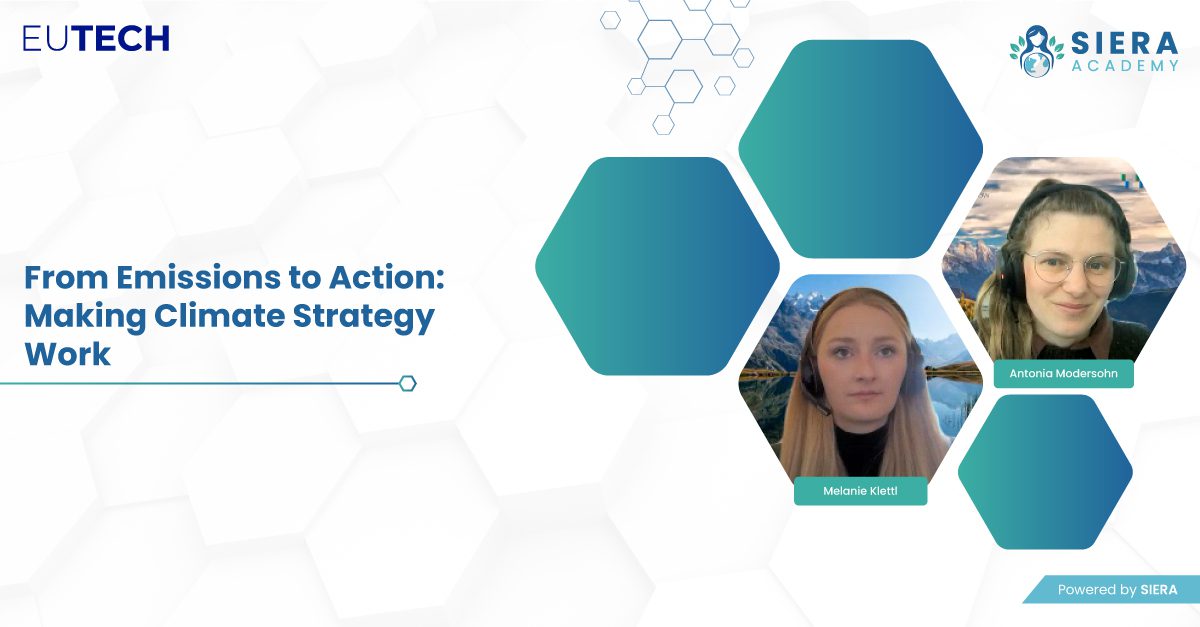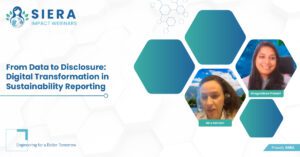From Emissions to Action – Making Climate Strategy Work: A Strategic and Technical Pathway to Corporate Climate Impact
Introduction: Turning Emissions into Climate Strategy
In the face of intensifying climate impacts and global regulatory changes, businesses must go beyond climate commitments and implement measurable action plans. Greenhouse gas emissions are no longer just an environmental issue—they are a direct risk to business continuity, financial performance, and market reputation.
In the SIERA Academy Impact Series webinar held on May 6, 2025, SIERA Alliance Members explored how companies can bridge the gap between emissions tracking and real climate strategy. The session, led by SIERA Alliance members, outlined actionable solutions to calculate corporate emissions, assess climate-related risks, and develop adaptive decarbonization roadmaps.
The discussion combined technical insights with practical applications, showcasing real-world case studies to highlight how companies and municipalities can align with EU policies, ISO standards, and global climate targets.
The challenge addressed in the webinar was clear: despite increasing regulatory pressure and growing corporate ambition, most companies still struggle to manage emissions effectively—particularly across complex Scope 3 categories. By examining these gaps and providing tested solutions, the webinar offered a detailed blueprint for transforming emissions data into strategic action.
Challenges in Corporate Emission Management
The session began with a deep dive into the systemic challenges companies face in their decarbonization journey. These challenges stem not only from technical limitations but also from structural and strategic blind spots that hinder long-term climate performance.
1. Incomplete Emissions Visibility
Many organizations continue to focus exclusively on Scope 1 and Scope 2 emissions, which cover direct operations and energy use. However, Scope 3 emissions—ranging from purchased goods and services to downstream product use—often represent the largest share of a company’s climate impact. Without full visibility into the supply and value chain, emission hotspots remain unaddressed.
2. Low Data Quality and Inconsistent Methodologies
Accurate emissions reporting relies on high-quality, granular data. But many suppliers lack the tools or expertise to track emissions accurately. As a result, companies are often forced to use outdated or generic emission factors, undermining the precision of their assessments. Different suppliers also use incompatible methodologies, making aggregation and comparison extremely difficult.
3. Compliance-Only Mindset
Instead of viewing emissions data as a tool for business performance, many companies approach climate strategy as a compliance task—meant to meet disclosure requirements such as CSRD or CDP. Without feedback loops, regular updates, or integration into core business functions, these strategies often become static and disconnected from operational priorities.
4. Fragmented Ownership and Execution
Sustainability goals frequently reside within ESG departments or external reporting units, rather than being embedded across procurement, finance, and operational teams. This fragmentation leads to gaps in execution and weakens the impact of climate plans.
5. Underdeveloped Climate Risk Management
Companies increasingly face two types of climate-related risks: physical (e.g., floods, heatwaves) and transitional (e.g., carbon pricing, policy changes). Yet these risks are rarely assessed in a systematic way. Without geospatial modeling, predictive tools, or scenario planning, organizations remain vulnerable to both short- and long-term disruptions.
These challenges, as detailed in the webinar, highlight the urgent need for integrated, data-driven, and performance-oriented climate strategies.
Opportunities from Strategic Emissions Management
Despite the difficulties, the session also presented a powerful case for seeing emissions as an opportunity—one that can drive innovation, cost savings, and regulatory resilience.
The SIERA Alliance members identified five main opportunity areas that result from advanced emissions management and strategic alignment.
Opportunities Summary
| Opportunity | Benefit |
| Scope 3 Transparency | Enables collaboration across value chains and better supply chain data |
| Enhanced Data Quality and Auditability | Supports CSRD reporting, SBTi alignment, and reliable performance metrics |
| Risk-Responsive Capital Planning | Allows climate-informed investments through scenario analysis |
| Adaptive and Dynamic Strategy Frameworks | Embeds feedback loops and real-time tracking into climate plans |
| Culture Shift through Change Management | Aligns internal behaviors with external climate goals |
These opportunities illustrate how emissions management, when treated strategically, can lead to performance improvements, risk resilience, and leadership in sustainable innovation.
Proposed Solutions: Turning Emissions into a Strategic Asset
The webinar introduced a structured approach for companies aiming to manage and reduce emissions across all scopes. By integrating best practices from regulatory frameworks like CSRD and technical standards such as ISO 14001 and 50001, SIERA Alliance Members outlined five practical and interrelated solutions to address emissions systematically and sustainably.
1. Gap Analysis and Scope 3 Materiality Assessment
A robust climate strategy begins with an understanding of where emissions originate and which areas matter most. The first step involves conducting a gap analysis of the company’s current emission tracking systems, followed by a Scope 3 materiality assessment.
The materiality assessment identifies categories that are most emission-intensive and where the company has the most influence. This approach helps avoid misallocation of resources and ensures that efforts are directed toward emission hotspots.
A quadrant-based method is used to categorize Scope 3 activities into four groups based on high/low emission intensity and influence. Categories with both high emissions and high influence—such as packaging or transport—are prioritized for accurate accounting and reduction planning.
For instance, in the webinar, it was suggested that a wine company working with bottle suppliers should request specific product carbon footprints from suppliers, rather than relying on average emission factors, to ensure reporting accuracy and strategy effectiveness.
2. Target Definition and Strategic Planning
After identifying key emission sources, the next step is to define measurable, science-based targets. These targets should align with the Science Based Targets initiative (SBTi), EU climate legislation, and ISO energy standards.
This phase involves both top-down and bottom-up planning:
- Top-down: Set ambitious long-term climate goals in line with international science and policy targets.
- Bottom-up: Ensure these goals are realistic and achievable based on current operations, financial capacity, and technological feasibility.
Companies also receive support in scenario modeling to visualize potential emission trajectories and build customized reduction roadmaps. These include intermediate milestones, key performance indicators (KPIs), and department-specific action plans.
The strategic rule emphasized throughout the session was clear: Reduction first, substitution second, compensation last. Avoiding emissions through operational improvements and technological changes must come before any offsetting or external compensation measures.
3. Climate Risk and Resilience Integration
To build long-term resilience, climate strategy must go beyond emissions counting and address exposure to climate risks. This includes integrating both physical risks (e.g., floods, heatwaves) and transitional risks (e.g., regulatory changes, market shifts) into enterprise risk management systems.
SIERA’s methodology incorporates geospatial mapping, predictive modeling, and scenario stress testing to identify vulnerable assets and operations. These tools inform strategic decision-making about site planning, supply chain redesign, and infrastructure investment.
The process is aligned with ISO 14090 and the EU Adaptation Strategy, ensuring both technical rigor and regulatory relevance.
4. Monitoring and Strategic Adjustment
A strong climate strategy is not static—it must evolve with new data, regulations, and innovations. The webinar emphasized the role of continuous monitoring and dynamic feedback systems using tools like SustainSuite.
As part of SIERA, SustainSuite enables real-time tracking of emissions, performance metrics, and strategy implementation. This supports audit-ready ESG disclosures and helps businesses adapt to shifting compliance landscapes such as the CSRD and ESRS frameworks.
The approach ensures that climate goals remain aligned with operational realities and that companies can pivot quickly when facing new risks or opportunities.
5. Organizational Change Management
Even the best-designed climate strategies fail without organizational alignment and capacity. Therefore, the final solution focuses on integrating sustainability into the culture and workflows of the business.
This includes establishing ownership across departments, training staff, and embedding climate goals into procurement, finance, and operations. The result is a transformation in which sustainability is not just a departmental responsibility but a company-wide value system.
Clear governance structures, employee engagement programs, and cross-functional collaboration mechanisms help build long-term accountability and resilience.
Case Study 1: Business Case for Green Electricity
During the session, a compelling case study illustrated how switching to renewable electricity produced both environmental and financial returns. A company that had been tracking its Scope 2 emissions noticed only minimal reductions despite ongoing energy-saving efforts.
The problem was rooted in the emission factor of Germany’s national grid, which rose from 0.37 to 0.43 kg CO₂/kWh between 2022 and 2023. This increased offset efficiency gains and limited visible progress.
SIERA consultants recommended shifting the electricity supply to certified green energy. This resulted in:
- A drastic drop in the emission factor to 0.032 kg CO₂/kWh
- Average electricity cost savings of €0.10 per kilowatt hour
- An estimated €4 million in annual savings for the company, based on large-scale consumption
This simple but effective solution allowed the company to reduce emissions significantly while also lowering operational costs. It highlighted the value of data-informed decision-making and strategic supplier engagement in achieving climate targets.
Case Study 2: Municipal Heat Planning for Climate Resilience
The second case study focused on public-sector emissions management through municipal heat planning (MHP). Conducted by seecon Ingenieure, the project targeted citywide decarbonization of heating infrastructure, a major contributor to Scope 1 and Scope 2 emissions in municipalities.
The MHP process included:
- Baseline Analysis: Assessment of current heat demand and emissions using GIS-based mapping and building energy data.
- Potential Mapping: Identification of renewable heat supply options, including industrial waste heat, solar thermal, and hydrogen infrastructure.
- Scenario Planning: Simulation of different technology pathways to 2045, evaluating CO₂ savings, cost efficiency, and infrastructure feasibility.
- Roadmap Development: Creation of actionable plans for implementation, with phased targets, investment needs, and funding alignment.
The project’s geospatial tools helped identify the areas of highest heat demand and proposed solutions that minimized energy loss and maximized integration with existing infrastructure.
Municipalities benefited by:
- Reducing emissions across multiple scopes
- Aligning with EU Taxonomy and ESG disclosure expectations
- Avoiding infrastructure overbuild and forced resettlement due to outdated heating networks
This case demonstrated how cities and local governments can adopt science-based approaches to meet national climate targets while enhancing social and economic resilience.
Take the Next Step with SIERA
At SIERA Alliance, we specialize in delivering data-driven emissions management solutions that align with SBTi, and EU Green Deal targets. Our expertise in Scope 1–3 emissions accounting, risk-informed strategy development, and ESG-aligned implementation helps businesses and municipalities transition from climate ambition to measurable climate impact.
Our services include:
- Carbon Footprint Assessments (CCF & PCF): We calculate corporate and product-level carbon footprints using standardized, audit-ready methodologies that form the foundation of strategic emissions reduction.
- Scope 3 Materiality and Target Planning: Our framework helps clients prioritize high-impact Scope 3 categories and define science-based targets aligned with international standards.
- Climate Risk & Resilience Integration: We use scenario modeling, GIS analysis, and ISO-aligned tools to assess climate-related risks and embed resilience into infrastructure, operations, and supply chains.
- SustainSuite: Our digital platform supports real-time emissions tracking, CSRD reporting, and performance monitoring to ensure transparency, compliance, and continuous improvement. Book a free demo today.
- Municipal Heat Planning and Sectoral Decarbonization: We offer tailored planning services for cities and public bodies to support heating transitions, reduce Scope 1 and 2 emissions, and align with EU funding requirements.
Get in touch with SIERA Alliance today to explore how our emissions solutions can help you reduce carbon impact, strengthen ESG performance, and ensure alignment with regulations and long-term sustainability goals. Our team of experts is ready to support your climate strategy—from data to action.









